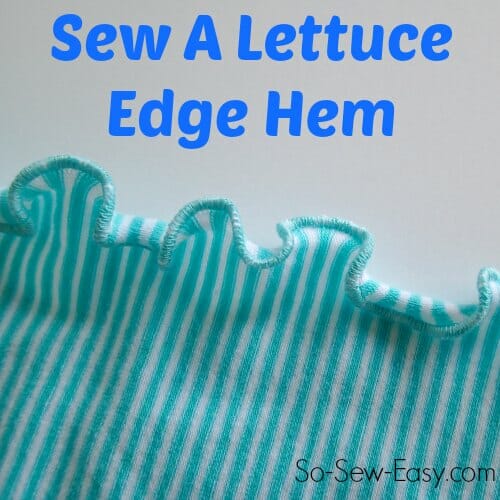
Do you own anything with a lettuce edge hem? Typically seen on little girls' clothes, but often in women's clothing too, on the hemline of casuals and maxi dresses. This curly-wurly hemline looks pretty and is practical too, adding no bulk to the hemline and no fabric is turned up so if you are short on length, this is a good way to finish without making your project shorter.
How to sew a lettuce edge hem
Some knit fabrics stretch just in one direction, others stretch in both directions. To sew the lettuce edge hem you'll need to sew with the stretch. This is because the fabric needs to stretch as you sew and then relax back again to create the wavy finish.
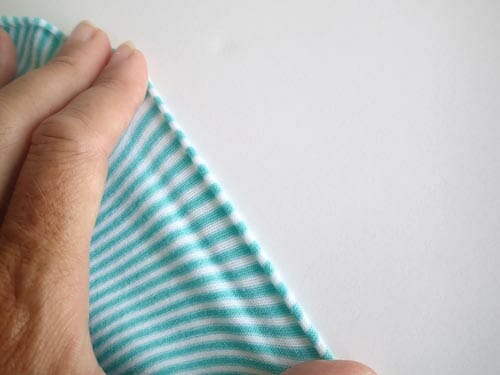

You'll probably also notice that thinner knit fabrics have a tendency to curl on the edges. In this case, that's good because we are going to use that curl to our advantage. Take the fabric you intend to hem and stretch it. Which way does it curl, towards the right or the wrong side? You'll want to work with the curl of fabric on the top as you sew.
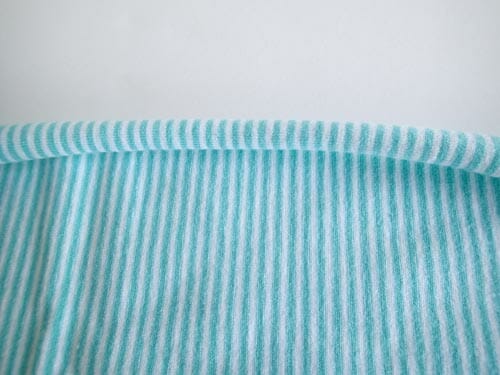

Cut a little of the fabric and do a test before working on your project to get the right machine settings. For mine, I used a stitch length of 0.3 and a width of 5.0.
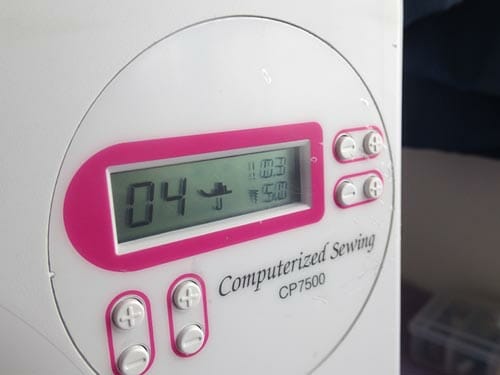

Lay the fabric under the presser foot, and pull the fabric at the front AND at the back, trying to keep even pressure each side. This stretches the fabric and causes it to roll a little. Aim the center of your presser foot at that roll, and sew your wide but very short zig-zag stitch over the little roll of stretched fabric.
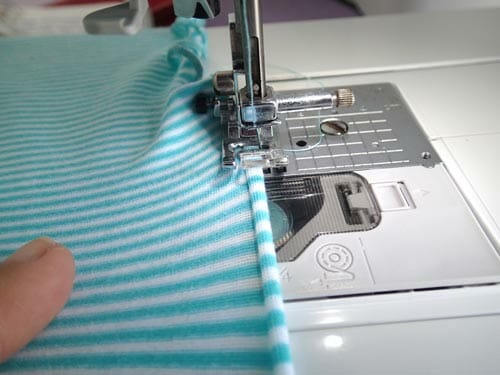

Once the fabric has had a chance to regain its original shape, the line of close stitching on the edge forces that edge to be longer now and so it curves and curls back and forth in a pretty wave.
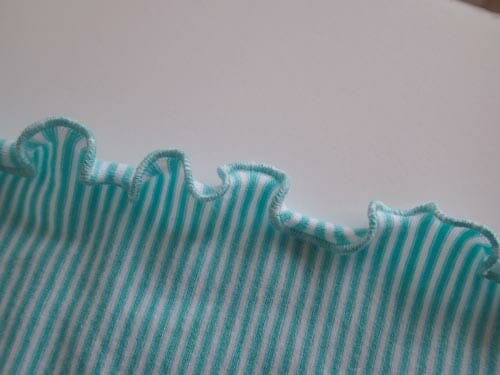

I'm working on a new pattern, where making this type of wavy hem is an added option, so why not pick up some old scraps of knit fabrics and get practicing. It's addictive!








Very helpful instructions ….. thank you.
[…] next tutorial you wouldn’t want to miss is How to sew a lettuce edge hem by So-Sew-Easy blog. Deby shows how to make the lettuce hem by a regular sewing […]
i want to know is it possible to hand sew a lettuce hem
I have never done it but, I think it can be done with a fishing line but only if you are using stretchable fabric.
You can do it with fishing line. It must either be stretchable or a woven cut on the bias. First, tie a knot in the end of the line. You can pass it quickly through a candle flame to set the knot so it won’t come untied. You can whipstitch the monofilament to the edge, turning a little bit of fabric under to encase the monofilament. After you whip several inches, then stretch the fabric along the line and it will curl.
Keep doing that to the end.
The only issue is that the stitches have to be pretty close together to get a nice effect, so it will take forever to do it by hand. I suggest doing a sample so you can understand what you’re getting yourself into timewise.
[…] Do you own anything with a lettuce edge hem? Typically seen on little girls clothes, but often in women’s clothing too, on the hemline of casuals and maxi dresses. This curly-wurly hemline looks pretty and is practical too, adding no bulk to the hemline and no fabric is turned up so if you are short on length, this is a good way to finish without making your project shorter. Learn how to sew lettuce with this free tutorial. […]
What fun to see this edge reappear some 50 years after I used it to add something different to my childrens’ T-shirts’ and dresses. Loved seeing you pass it on to another generation.
I like to see it come back too, plus it adds a feminine touch to garments – some you pay extra just to have detailing like this.
My sister & I had matching pale pink t-shirts with these edges. I had forgotten them until now – the stitching on the edge was done with a contrasting thread. I am going to try!
I’m going to try this hem on my next project!
Thank you for yet another great tutorial. I just cut out lounging pants (using your wide leg pants pattern) in a knit that curls. I think this will add a nice little “twist” to the hem.
I know it’s possible to do this on an overlocker too, but as a newbie to overlooking, I haven’t a clue how to go about it. I guess it’ll mean tampering with all of those scary dials and changing the settings. Any ideas?
Lift the knife out of the way so your not cutting the edge then just follow these directions. Looks fantastic.
IF you do own a serger, many provide an additional accessory for constructing an overcast stitch similar to what you see on linen (table) napkins. (It is a different feed dog plate and is used with a specific machine setting.) All said, I used such a finish when making a sheer (organza) bolero/shrug that had set in sleeves and a center back seam and it worked out very well as the seam allowances were barely visible whereas to finish the hemlines on the sleeves, etc. I used a small rolled one, using a haute couture method.
WOW!! You make it look so simple. You’ve inspired me to give it a try .. I have all sorts of ideas for using it swirling around in my head. Wish me Luck and Thank you so very much for sharing this with us all. 🙂
looks easy
how can you do a lettuce edge on woven fabric like cotton and broadcloth
Often done with fishing line straight of the reel as that curls up on its own. Basically you encase the filament line inside the stitches as you sew, being careful to not break the line or sew through it. The natural curl of the line then curls the fabric. That’s the theory anyway! Never actually tried it personally but seen lots of tutorial videos on the subject.
If you used something like a pin tuck foot you could use one the ‘grooves’ as a guide for the fine fishing line too actually 😉
Love your blog!
Thank you so much!
@acraftteacuppa: The method you mention does work, however it gives a somewhat crisp finish often referred to a ‘lettuce leaf finish’. ☺
Actually, the fishing line method works best on woven fabric that either has a bit of stretch to it, or that is cut on the bias. I’m not sure how it would turn out on non-stretch fabric cut on the straight grain.
I have been making all kinds of stuff for my Grand daughter. This will definitely something I will try. Would love a serger but for now my machine is just fine. I just am trying to learn how to use some of the fany stiches it has on it. Thank you.
wow! this is so awesome! thank you for the detailed instructions. i do have a serger but i wasn’t keen to play with the settings on it. this comes out beautifully. thank you!
Try to find a local workshop for your serger/overlocker. I went to one recently and learnt so much. No fear of changing all the settings now, I’m dial happy.. it was just 3 hours long but I learnt so much and came home exhausted and full of ideas.
I’m not new to sewing, but I am new to making things I can actually wear outside my front door, thanks for this tutorial, it’s fab!
Thanx so much. I have been sewing for many years. Crafts, boys clothes, costumes, alterations, repairs & girls clothes if very simple. Alas I have several grand- daughters. They think I can do anything. I thought also acording to my many sewing books that I needed a serger for an edge like this. I have a Valentine dance dress to hem. I will give it a whorle. Thanx again. JP
Hi, I’m pretty new to sewing and I’m making this dress:

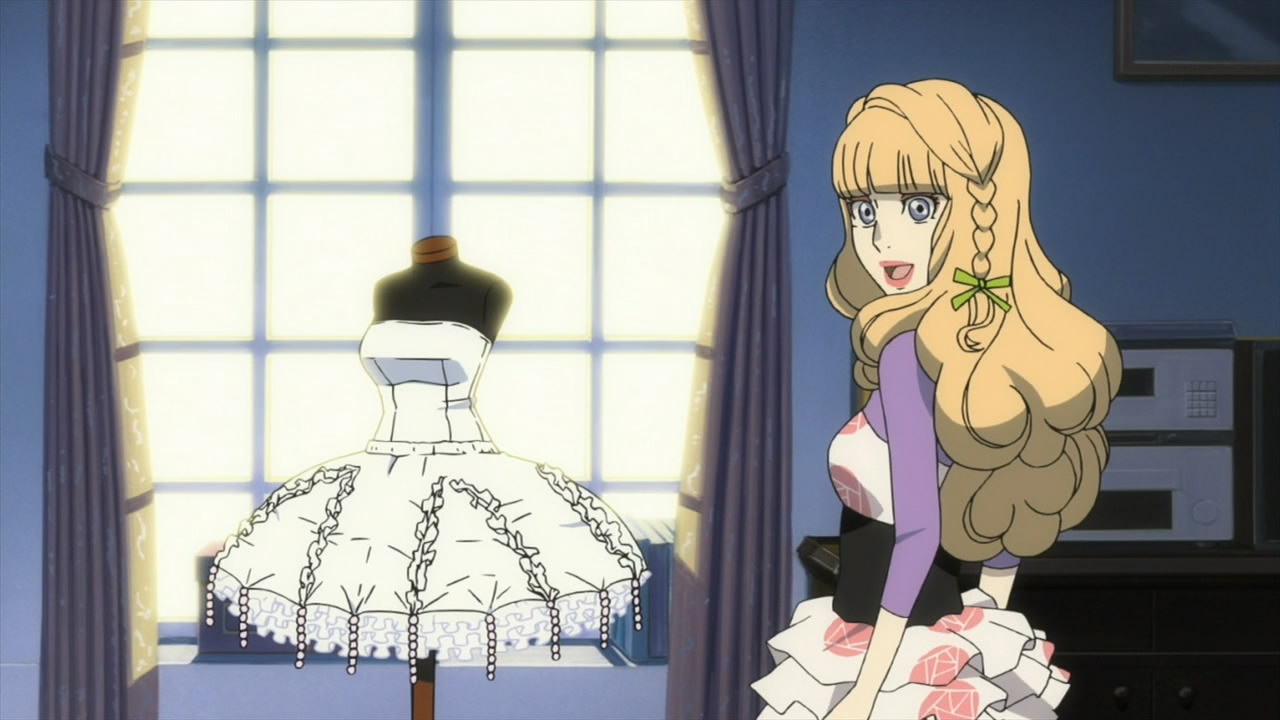
Poofy, I know XD
But I’ve decided to forgo petticoats and make three tutus out of glitter organza- and as you can see, the fringe for the underskirt is very wavy, like what you’re doing. I’ve never touched organza, haha, so I was wondering if this would work with that fabric? Thank you!
This technique only works on fabric that stretches, so unless the fabric you choose has a good stretch to it, I don’t think it will work. I’ve seen a technique where you sew fishing line into the hem to make it stiff and wavy, perhaps that would be more what you are looking for.
I do this on the necklines of t shirts and the sleeves. It makes t shirts for little girls look more feminine.
What other types of fabric can we use this technique on?I have seen some non-knit fabrics with lettuce edge, with the support of a wire or something like that.
Yes, you can use it on light fabrics like a tulle or netting where a length of fishing line can be sewn into the edge of the hemline within the row of zig-zag stitches and create a much wider kind of ripple of fabrics that wouldn’t usually stretch as much. You’ll more commonly see that kind of thing on little girls skirts or multi-layered skirts and things like ballroom dancing costumes.
Hi Deby, I have an rolled edge foot for my machine, I used it mostly for linen napkins, but it make a great lettice edge seam.. I must try your way to see what the difference is…..
Well, this is a winner! I am going to have to try!
Huh. I always thought you needed a serger for this edge. Thanks for sharing this technique! Thanks for linking up to Inspire Us Thursdays!
Hey Deby,
This is a great tutorial.
Debi
I didn’t realize it was even possible to do this kind of a stitch on a sewing machine instead of a serger! Thanks for showing me how!
So, you’re using a zig-zag stitch, right? I had actually tried this on my serger but since I haven’t put my thinker on to figure out if I need more or less thread along the hem it didn’t turn out so well 😉
What is the default setting for your stitch length when you turn your machine on? (Your numbering is different than mine, I think – my machine defaults to 2.5)
Yes, mine also defaults to 2.5 stitch length – I think its in millimeters. Or at least I assume that’s what it is. You may need to get our some scraps and experiment to see what settings work best for you. Different fabrics might also need different settings too depending on how thick they are, and how much they roll. Good luck.
Your photo gave me an insta-flashback to hanging out in my grandma’s sewing room when I was young. She taught me how to do this, because I wanted “fancy” sleeves. 🙂
Thank you for this tutorial. Initially I also thought this was done on a serger and was gutted. I have been following your blog regularly because I am a beginner and saw the fantastic projects you have made merely using the lowly sewing machine. A serger is not even on my radar! So pleased to read it has been done on a regular machine. Looks so professional!
A serger is certainly on my sewing wish list for one day, but until then, I can get by doing almost everything I need to on a regular machine. There are so many special presser feet available too that help out. This with the pretty hem is one of my favorite new skills!
ohhh neato!! great tute! I will practice 🙂
I thought you could only do this on a serger, but that is a sewing machine you are using, right?. Thanks for the tips!!
Yes, I’m just using my regular sewing machine -nothing fancy. For all of us without those fancy machines, there is still a lot we can do on the regular sewing machine.
Great tip! Pinned:)
Wow, I have sewn a lot over the years, but have not done this stitch. I have something in mind for this ruffle. You make it look so easy. Thanks for the tutorial.
Bev
It was a first time for me too, but I’ll certainly be looking for more ways to use it. Thanks for dropping in Beverly.
I love this stitch. It’s so easy and add such eye appeal. Thanks for teaching us how to do it. 🙂
Thank you for taking the time to leave a comment, Cookie!
Thank you for sharing this tutorial, I will pin this for later.
Thank you so much for this tutorial! Well written 🙂 I can’t wait to try it!
Thank you. I love your crochet site – its all so pretty! It’s just more thing on my list of stuff to learn one day.
I’ve also used my serger for this result. I removed the first needle so that I got a narrower stitch and then I made the stitch very short.
Sadly I don’t have a serger (yet?), but I understand this finish is pretty easy to achieve with the right settings. I really love your Flouse dress by the way, that fabric is just so lovely.
wonderfull always want to know how to do it
thx